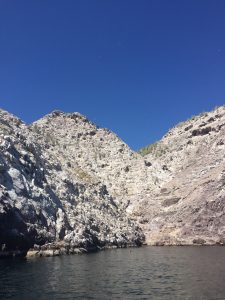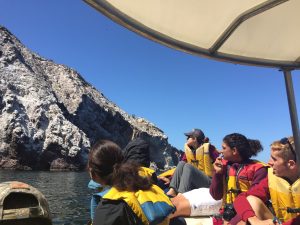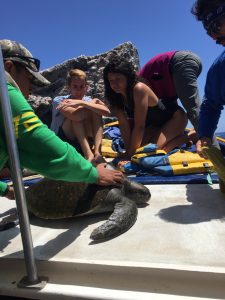This past Sunday, we returned from a six-day camping trip on the southwestern side of Isla Tiburon. We traveled there and camped with a group of six Seri community members and the boat captain from Prescott College. I love camping. When I am out in the wild, immersed in nature, I am in my element.
A question we have been talking a lot about on this trip (informally outside of class time) is “what is your ecosystem?” I brought this question up near the beginning of the trip, when talking about how backpacking trips I took in the Sierra Nevada mountains as a kid shaped what landscapes and natural settings I find most beautiful, feel the most inspired by and, to some degree, where I feel most comfortable. This question was a great one to ponder as we lived in and explored one of the most beautiful natural settings I have ever visited. We camped on a beach on Tiburon Island, but every day, we traveled on a panga boat to other nearby islands. These days were full of time exploring a new ecosystem and all the life that existed within it. Perhaps I am not a creature of this given place, but I recognized the beauty, wonder and uniqueness of these islands adrift in the Gulf of California.
After setting up camp upon arrival on Tiburon, we motored over to the other side of the bay where Humberto, a member of the Seri tribe who had come along on the trip with us, led us on an informative hike. He pointed out various plants that the Seri used for everything from recovery after childbirth to food sources to warding off witchcraft. He moved extremely quickly over the landscape, obviously comfortable in the desert. This was the Seri’s ecosystem; they have lived and thrived on this island for hundreds of years and have a very important relationship with and knowledge of this area. I felt very much a foreigner who can admire the beauty of the landscape without feeling the stress of survival in the desert, since I had a warm place to sleep and a reliable source of food and water.
The next day, we took a long boat ride to Isla San Pedro Martir. The isolated, volcanic island is millions of years old and home to a huge variety of nesting birds, such as red-billed tropicbirds and blue- and brown-footed boobies. The entire island is coated in guano that has turned the island white, which has altered the ecosystem. The white cliffs reflect more sunlight and stay cooler than normal, allowing birds that could not normally stand the heat to live on the island.


Below the steep white cliffs, dozens of sea lions play in clear, turquoise water. We stopped in a cove, donned our wetsuits and plunged into the frigid water to snorkel with these amazing mammals. The sea lions, adorably awkward on the rocks above, were graceful and fluid in their twirling movements under the water. They eagerly came over to explore the newcomers to their ecosystem, blowing bubbles in my face as they swam close only to duck away at the last minute.

The cold drove many of us out of the water after only a few minutes, but we still felt like we had the experience of a lifetime. We were sunning on the bow of the boat when Cosme, our boat captain, pulled aboard a green sea turtle. Cosme is part of a turtle conservation group that records and tags turtles in the gulf. This was the closest I had ever been to a turtle; the creature looked ancient and commanded respect. Once we let the turtle go back into the water, we sped off to investigate a whale spotted offshore from the island. When we got there, it was identified as a humpback. It surfaced often since it was feeding near the surface. We watched it come up, spout and dive back down with a flip of its huge tail. As we prepared to leave, it came up one final time and started waving its flippers back and forth in the air, as if it is waving goodbye to us.


As we began a long boat ride back to our campsite, I sat back in awe of all that we had just seen. We were visitors to this vibrant ecosystem anchored to an ancient island in the middle of the gulf. This water and land belongs to the sea lions and birds and whales and sea turtles that thrive in it. It is their ecosystem. How can one visit a place like this and not be a conservationist? Had I not already been one before, the powerful experience of sea lions twirling and swimming around me in crystal clear water would have converted me.
The day was capped off with an experience that somehow trumped the rest. Once the sun had gone down, we again boarded the panga boat for a night ride to see bioluminescent dinoflagellates. The night was still, the water so black I could not tell where the sky ended and the ocean began. Stars reflected on the surface. As the boat sped up, it kicked up spray that glowed bright in the darkness. It felt like we are floating on a galaxy, leaving a trail of stars in our wake upon a second night sky. We came as social scientists and biologists and ended up astronauts, floating in a whole other world, a completely unrecognizable ecosystem.
As I reflect back on all that I saw in a mere 36 hours, I recognize the unifying beauty and powerful vivacity that existed in and united each of the scenes I witnessed. I can recognize the same in other ecosystems I have had the privilege to briefly be a part of. We humans may have one ecosystem we prefer above another, but our species inhabits every corner of the globe. We live in and play in and shape each and every ecosystem, just like the sea lions and whales and birds do in theirs near San Pedro Martir. I believe that means we have a duty to protect these ecosystems we inhabit, whether it be one where we are a visitor or a long-term resident.
It takes getting out and experiencing the world to build love and respect for nature and the biodiverse life it holds. During the bioluminescence boat ride, as I stared at the bright spray and starry night, I felt so profoundly connected to the world around me. Just as with the sea lion snorkel, this is the thing that converts the non-believers. My “ecosystem,” as defined by my question, may be a specific type. But I also feel that it is any place like this, where dominant qualities are wild and full of life, and my very existence in this place at this time gives me a profound feeling of connectivity to the world around me. I feel so lucky to have gotten a taste of that in this special place, in a corner of the world few get to visit. I hope that others are as inspired as I am by the ecosystems they live in, both here and all around the world. Ponder the question, “what is your ecosystem?” and then go seek it out. Adventure and inspiration awaits.
